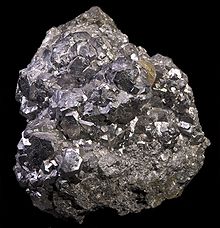
Back سكوتيروديت Arabic Skutterudita Catalan Skutterudit German Σκουττερουδίτης Greek Escuterudita Spanish Skutterudita Basque اسکوترودیت Persian Skuttérudite French Skutterudite Italian スクッテルド鉱 Japanese
| Skutterudite | |
|---|---|
 Skutterudite from Bou Azzer, Morocco | |
| General | |
| Category | Arsenide mineral |
| Formula (repeating unit) | CoAs3 |
| IMA symbol | Skt[1] |
| Strunz classification | 2.EC.05 |
| Crystal system | Cubic |
| Crystal class | Diploidal (m3) H-M symbol: (2/m 3) |
| Space group | Im3 |
| Unit cell | a = 8.204 Å, Z = 8 |
| Identification | |
| Color | Tin-white to silver-gray, tarnishes gray or iridescent; in polished section, gray, creamy or golden white |
| Crystal habit | Crystals are cubes, octahedra, dodecahedra, rarely prismatic; in skeletal growth forms, distorted aggregates; also massive, granular |
| Twinning | On {112} as sixlings and complex shapes |
| Cleavage | Distinct on {001} and {111}; in traces on {011} |
| Fracture | Conchoidal to uneven |
| Mohs scale hardness | 5.5–6 |
| Luster | Metallic |
| Streak | Black |
| Diaphaneity | Opaque |
| Specific gravity | 6.5 |
| References | [2][3][4][5][6] |
Skutterudite is a cobalt arsenide mineral containing variable amounts of nickel and iron substituting for cobalt with the ideal formula CoAs3. Some references give the arsenic a variable formula subscript of 2–3. High nickel varieties are referred to as nickel-skutterudite, previously chloanthite. It is a hydrothermal ore mineral found in moderate to high temperature veins with other Ni-Co minerals. Associated minerals are arsenopyrite, native silver, erythrite, annabergite, nickeline, cobaltite, silver sulfosalts, native bismuth, calcite, siderite, barite and quartz.[3] It is mined as an ore of cobalt and nickel with a by-product of arsenic.
The crystal structure of this mineral has been found to be exhibited by several compounds with important technological uses.
The mineral has a bright metallic luster, and is tin white or light steel gray in color with a black streak. The specific gravity is 6.5 and the hardness is 5.5–6. Its crystal structure is isometric with cube and octahedron forms similar to that of pyrite. The arsenic content gives a garlic odor when heated or crushed.
Skutterudite was discovered in Skuterud Mines, Modum, Buskerud, Norway, in 1845.[4] Smaltite is an alternative name for the mineral. Notable occurrences include Cobalt, Ontario, Skuterud, Norway, and Franklin, New Jersey, in the United States. The rare arsenide minerals are classified in Dana's sulfide mineral group, even though it contains no sulfur.
- ^ Warr, L.N. (2021). "IMA–CNMNC approved mineral symbols". Mineralogical Magazine. 85 (3): 291–320. Bibcode:2021MinM...85..291W. doi:10.1180/mgm.2021.43. S2CID 235729616.
- ^ Mineralienatlas
- ^ a b http://rruff.geo.arizona.edu/doclib/hom/skutterudite.pdf Handbook of Mineralogy
- ^ a b http://www.mindat.org/min-3682.html Mindat.org
- ^ http://webmineral.com/data/Skutterudite.shtml Webmineral data
- ^ Klein, Cornelis and Cornelius S. Hurlbut, jr., Manual of Mineralogy, Wiley, 20th ed., 1985, p. 289 ISBN 0-471-80580-7